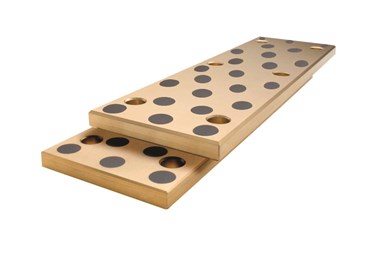Understanding Self-Lubricating Components
Recognizing that they are essentially conventional components with lubricant added in the form of graphite will help the molder realize their significant benefits.

Although self-lubrication adds about 20 % to the cost of a conventional component, such self-lubricating components offer maintainability, reliability, simpler designs and a clean operation. Photo Credit: SelfLube Co.
Using self-lubricating mold components has significant benefits, but only if the molder truly understands what these components are: essentially a conventional component with lubricant added in the form of graphite plugs. Graphite is a solid lubricant, so, for those molders who are used to working with liquid lubricants such as grease or oil, a solid lubricant may seem a little strange, and so might the graphite itself.
Graphite has a near-zero coefficient of thermal expansion, which means that it doesn’t expand and contract with temperature changes like ordinary substances do. It’s not a metal, but it conducts electricity like one. It also doesn’t melt. Instead, it remains a solid at temperatures ranging to 10,000°F and then becomes a gas. It’s not very strong, but it can be formed into composites with incredible strength.
The strangest thing about graphite, however, is its molecular structure. It’s a two-dimensional crystal, and since we live in a three-dimensional world, a two-dimensional object seems to defy all logic. Graphite is one of two crystalline forms of ordinary carbon. The other is diamond, which is a conventional three-dimensional crystal, meaning it is strong in all three dimensions. Because graphite is a two-dimensional crystal, it is strong in just two dimensions.
What appears to be a solid chunk of graphite is actually a stack of very thin (one-atom-thick) crystal sheets. These thin sheets tend to slip and slide around on each other and can be easily peeled off, which turns out to be a very useful property for its use in moldmaking.
We all know that graphite makes for an excellent writing instrument. The word “graphite” comes from the Greek word grapho, which means “to write.” However, it is the same “slippery” property that’s evident when it’s used in writing that makes graphite highly useful as a lubricant as well. When you rub a pencil lead, it feels oily, although in reality, it is not oily. It is completely dry. What you are feeling is the slipping and sliding of its one-atom-thick crystal sheets. It is precisely this action that makes graphite such an excellent solid lubricant.
Features and Functions
The main function of a self-lubricating mold component is to guide and control movement. Such a mold is typically made of aluminum bronze, an excellent bearing material, with embedded graphite plugs. The mating part of the mold (the one being guided) is usually made of hardened steel. As the two parts move relative to each other, the very slippery one-atom-thick sheets of graphite peel off and become distributed over the wear surface. With each cycle, a bit more graphite is distributed, so the process continuously replenishes. Graphite doesn’t evaporate and is relatively inert, so the lubrication it imparts is essentially permanent.
Although self-lubrication adds about 20 percent to the cost of a conventional component (one that must periodically be greased), there are several benefits for this extra cost:
• Maintainability. The need for periodic greasing is eliminated, which means, over the life of the tool, the savings in preventive maintenance (PM) is likely to be several times the upfront cost for self-lubrication.
• Reliability. Lubrication is always present, eliminating the risk of failure or shortened life due to skipped PM. Also, the absence of liquid lubricants means there is nothing to attract grit and other contaminants to wear surfaces.
• Simpler designs. With self-lubricated components, there is no need to make provisions for periodic lubrication, which removes a design constraint, potentially reducing costs and/or improving functionality.
• Clean operation. No liquid lubricants to drip or spatter on parts means a very clean operation with less scrap and rework.
Related Content
Solving Mold Alignment Problems with the Right Alignment Lock
Correct alignment lock selection can reduce maintenance costs and molding downtime, as well as increase part quality over the mold’s entire life.
Read MoreTreatment and Disposal of Used Metalworking Fluids
With greater emphasis on fluid longevity and fluid recycling, it is important to remember that water-based metalworking fluids are “consumable” and have a finite life.
Read MoreRevisiting Some Hot Runner Fundamentals
What exactly does a hot runner do? If you’ve been in the injection molding industry for any length of time, you might think the answer is obvious, but it is not.
Read MoreMachining Center Spindles: What You Need to Know
Why and how to research spindle technology before purchasing a machining center.
Read MoreRead Next
How to Use Continuing Education to Remain Competitive in Moldmaking
Continued training helps moldmakers make tooling decisions and properly use the latest cutting tool to efficiently machine high-quality molds.
Read MoreHow to Use Strategic Planning Tools, Data to Manage the Human Side of Business
Q&A with Marion Wells, MMT EAB member and founder of Human Asset Management.
Read MoreReasons to Use Fiber Lasers for Mold Cleaning
Fiber lasers offer a simplicity, speed, control and portability, minimizing mold cleaning risks.
Read More




















